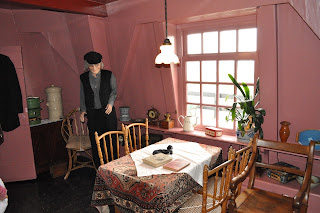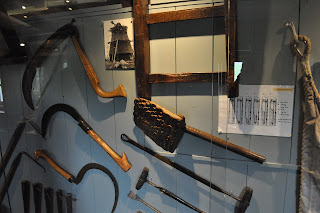It is not hard to gander at the 17th century windmills scattered around the polders (low-lying tracks of land with controled water) of North Holland. The numerous icons, seen in distant fields or viewed up close, keep part of the past alive and are constant reminders that this is indeed Holland.
The taller, modern windmills about the area generate the “green” electricity to which we chose to subscribe with our local power company when moving here, but what about the old windmills? A short drive - or long and pleasant bike ride - up from Amsterdam will reach the Museummolen at Schermerhorn, which calls itself ‘’a top-class museum below sea level.” Visitors can climb inside the big old devices to learn more at this neat little museum that looks like it is sitting in the middle of nowhere on highway N243.
“God made the Earth, but the Dutch made Holland.” I thought this statement sounded a bit strange when I first heard it at the museum, but the fact is that most of Holland is 1 – 4.5 meters below sea-level, and the inhabitants here hundreds of years ago had to find a way to drain the land where they wanted to live and farm. No electricity yet, but lots of wind around here made windmills famous for pumping water out of areas where people wanted to be. As strange as the statement sounded at first, the Dutch accomplished some almost supernatural feats in making their own land.
It is all pretty basic in the design of how wind turns the sails (arms), which turn an inner wheel, which turns the upright shaft going down in the body of the windmill, and is connected to another wheel at the bottom that turns the Archimedean screw down in the water. This large screw looks like the screws on the bottoms of power equipment made to dig holes for fencing and farming. The water rides up the ridges of the screw in its spiraling motion, to be transported to the next canal over, where another windmill not far away could take over by sending the water onto other directions and holding canals. Yes, just that simple and effective.
The museum itself is relatively small, but has old-world character. A cinema room shows a short film about the history and technology. The staff was glad to put the films in English and French for our visiting group. Various tools and models are on display inside, with a little café and of course, a gift shop.
Continue out the main building to enter one of these old devices. The miller’s living quarters on the lower level is preserved as it was back then, complete with manequins for atmosphere. And it is almost exciting to climb up the narrow stairways inside to reach the top as the internal shafts are turning nearby. Outside, there is a farmhouse with old tools and plenty of polder to stare at while imagining how things used to be.
The man and woman working at the museum were polite during our visit, but they made sure we were on our way out of the museum at 4:55, five minutes before closing. The man was dancing and making drinking gestures behind the front counter, while telling us that they were on their way to a marriage anniversary party as soon as the doors shut behind us. A tour bus pulled up outside the museum at 5:05 as we were getting on our bikes to head back to Alkmaar. The 50 or so '50-something' aged group unloaded the bus, and then looked disappointed to learn that the staff had locked up and were on their way to a hoedown.
http://www.museummolen.nl








No comments:
New comments are not allowed.